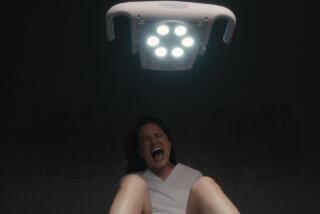Herzog’s Chronicle of a ‘Fiend’-ish Friendship
- Share via
Director Werner Herzog and actor Klaus Kinski were made for each other, and their five films together, beginning with their 1972 masterpiece “Aguirre, Wrath of God,” reveal Herzog’s obsession with exploring the outermost limits of human experience and Kinski’s mesmerizing gift in portraying men driven to risk madness in attaining all but impossible goals.
Kinski’s Aguirre is a 16th century Spanish conquistador who becomes a cruel, savage monster in his unrelenting search for El Dorado in the wilds of the Peruvian jungle. Similarly, in the title role of “Fitzcarraldo” (1982) Kinski is an opera-loving Irishman, a failed railroad builder and a struggling ice manufacturer who realizes he must belatedly join the Peruvian rubber boom if he is to realize his absurd dream of building an opera house in Iquitos, which he intends his idol, Enrico Caruso, to inaugurate. To do this, Fitzcarraldo ends up trying to haul a steamship over a mountain in order to harvest rubber.
Herzog and Kinski went on to do a stylish 1978 remake of “Nosferatu,” an homage to F.W. Murnau’s silent original, with Kinski a perfectly cast Count Dracula. They followed it up with a bleakly brilliant film of Georg Buchner’s “Woyzeck,” in which Kinski’s desperate, haunted army private is a virtual slave to his captain and is made to be a guinea pig in a crazy starvation diet experiment staged by a 19th century Dr. Mengele.
*
Their partnership ended in 1988 with “Cobra Verde,” with Kinski cast as an exploited Brazilian peasant turned bandit, who is sent off to revive the slave trade in West Africa only to end up leading a rebellion against the mad King of Dahomey. “Cobra Verde,” widely regarded as a disappointment, was scheduled for a local release only to be withdrawn, never to resurface.
Now Herzog has made a heartfelt homage to Kinski that’s alternately funny, tender and downright scary--”My Best Fiend,” in which he recounts his tempestuous relationship with the actor. Kinski was every bit as driven as the director but had considerably less self-control, to put it mildly, although Herzog owns up to his own moments of madness, recorded memorably in Les Blank’s “Burden of Dreams,” his documentary on the making of “Fitzcarraldo.”
A world-class egomaniac given to volcanic eruptions of rage on the slightest provocation, Kinski could also be a caring and thoughtful man, as both Eva Mattes and Claudia Cardinale, his leading ladies of “Woyzeck” and “Fitzcarraldo,” respectively, attest. Kinski was small and wiry and fair-haired; he had a striking, mobile face with a strong jawline and large, expressive eyes and sensual lips. In rare moments of repose he could seem handsome, but his most characteristic look was that of a tormented gnome. Off-screen he could be charming and likable despite a blazing intensity that could leave one feeling drained and exhausted.
Herzog, who revisits key locales in both his friendship and professional relationship with Kinski, even returning to the Peruvian jungle, can never say he didn’t know what he was getting into when he sent Kinski a script of “Aguirre.” That’s because he actually met the actor when he was only 13, and he and his mother and two brothers were all living, in the mid-1950s, in one room of a bohemian Munich boardinghouse (now restored to Architectural Digest splendor) where Kinski, establishing himself both in films and the theater, was living in a tiny servant’s room off the kitchen. Indeed, Herzog’s first recollection of Kinski was when he holed himself up in the bathroom in a 48-hour fit of rage during which he wrecked everything he could. (We get to see Kinski in awesomely sustained high dudgeon over a meal not to his liking during the shooting of “Fitzcarraldo.”)
Somehow director and actor had enough understanding and respect for each other for long enough periods of time to make their five films, glimpsed in an array of fine clips, although Herzog says that both Kinski and their working relationship were burning out by the end of “Cobra Verde.” Herzog sticks only to what he knew of Kinski from first-hand experience and does not speculate as to the source of the actor’s stormy emotions.
You couldn’t get Kinski, born in 1926 of Polish descent, to open up about his formative years. In any event, he left you with the sense that, whatever he might volunteer, beyond leaving an impression of youthful hardship and poverty, might not be reliable anyway. “My Best Fiend,” in fact, leaves you feeling that it is nothing less than a miracle that Herzog was actually able to work with Kinski at all. Herzog nevertheless has said that the notion that Kinski might actually have been insane “can only be justified from a petty and mediocre standpoint.” Herzog says simply that Kinski, “the most fascinating actor I know,” had “burned out” when he was found dead at 65 in his Northern California home in 1991.
The Nuart will screen “My Best Fiend” through Thursday and will screen “Woyzeck” Saturday at noon and “Aguirre, Wrath of God” Sunday at noon.
*
Unrated. Times guidelines: language, some violence.
‘My Best Fiend’
A New Yorker Films presentation. Director-narrator Werner Herzog. Producer Lucki Stipetic. Executive producers Andre Singer, Christine Ruppert. Cinematographer Silvia Vas. Editor Joe Bini. Music Popol Vuh. Archival research David Silberberg. Running time: 1 hour, 35 minutes.
Exclusively at the Nuart, 11272 Santa Monica Blvd., West Los Angeles, (310) 478-6379.
More to Read
Only good movies
Get the Indie Focus newsletter, Mark Olsen's weekly guide to the world of cinema.
You may occasionally receive promotional content from the Los Angeles Times.










